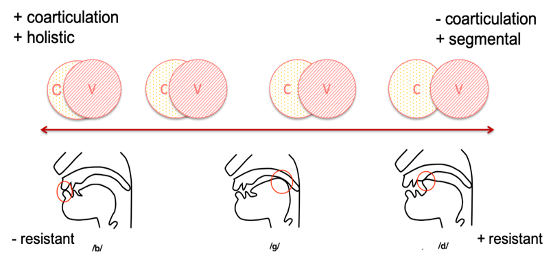Coarticulation
A metric to study spoken language fluency (development)
Human beings are endowed with the unique ability to communicate orally with others. While the act of speaking is very natural and effortless for adults, it takes more than a decade for children to become proficient speakers in their native language. Sometimes, neurocognitive or articulatory challenges may affect the typical course of their language progression.
In this research, we are interested in understanding how children develop the articulatory coordinations necessary for speaking fluently and how this happens concomitantly with phonological development. More specifically, we study (co)articulatory mechanism. Coarticulation underlies the ability from our speech motor system to produce speech segments continuously in various sized chunks (syllables, words, sentences). Coarticulation is therefore essential to spoken language fluency. In this domain, a central question remains whether speech motor gestures are initially organized in smaller or greater phonological units in children compared to adults in the native language and how patterns evolve over time to (1) lead to spoken language fluency, (2), signal deviant trajectories. To address this pressing question, we carry out kinematic studies in adults who have a full knowledge of their language and a mature control of their speech motor system and in children starting in preschool at the age of 3 up to 10 years of age in primary school.
Selected results:
A quantitative cross-sectional investigation of 62 German children from 3- to 7-year-old have highlighted significantly greater vocalic anticipation in 3-, 4-, and 5-year-old compared to 7-year-old children and compared to adults (within syllables: Noiray et al. 2018; across syllables: Rubertus & Noiray, 2018). The finding supported the view of a holistic organization of articulatory gestures in children around large linguistic chunks of at least the size of a syllable (Nittrouer et al., 1996). In German adults, we found gradients of lingual coarticulatory overlap between neighboring phonemes which directly result from the articulatory demands upon the tongue for a given consonantal context (Figure 1).

Syllables recruiting distinct primary organs (e.g., the lips to produce the consonant and the tongue for the vowel in /ba/) permitted greater temporal overlap of lingual gestures than syllables recruiting subparts from a single organ (e.g., the tongue tip for /d/ and tongue dorsum for /u/ in /du/). In the latter case, vocalic influences over tongue gestures during the consonant production were minimal. Our results thus provided evidence that consonants play an important role in moderating vocalic influences throughout the coarticulated stream when segmental intelligibility may be endangered.
Interestingly, children also exhibited contextually induced gradients of coarticulation, but to a lesser extent than adults. This result suggests that at least until the end of the first year into primary school, the articulatory differentiation of speech motor gestures for individual segments is not yet mature. Gestures are instead largely co-produced. This interpretation was later supported in a comparative investigation of empirical and simulated productions carried out with German children and adults (Abakarova, Fuchs & Noiray, 2022). Comparable observations were made regarding vocalic carryover (left-to-right) influences in the same sample of children and adults (Rubertus & Noiray, 2020).
Publications
Abakarova, D., Fuchs, S. & Noiray, A. (2022). Developmental differences in coarticulatory patterns relate to differences in speech motor strategies: An empirically grounded modeling approach. Journal of Speech, Language, and Hearing Research, 1-24 paper.
Rubertus, E., & Noiray, A. (2020). Vocalic activation width decreases across childhood: evidence from carryover coarticulation. Laboratory Phonology, 11(7), 1-27 paper.
Noiray, A. Ries, J., Tiede, M., Rubertus, E., Laporte, C, & Ménard, L. (2020). Recording and analyzing kinematic data in children and adults with SOLLAR: Sonographic & Optical Linguo-Labial Articulation Recording system (SOLLAR). Laboratory Phonology: special collection: Techniques and Methods for Investigating Speech Articulation, 11(1): 14, 1-25 paper.
Noiray, A., Wieling, M., Abakarova, D., Rubertus, E., & Tiede, M. (2019). Back from the future: nonlinear anticipation in adults and children´s speech. Journal of Speech, Language and Hearing Research, 62(8s), 3033-3054 paper.
Rubertus, E., & Noiray, A. (2018). On the development of gestural organization: A cross-sectional study of vowel-to-vowel anticipatory coarticulation. PLOS One, 13(9), 1-21 paper.
Abakarova, D., Iskarous, K., & Noiray, A., (2018). Quantifying lingual coarticulation in German using Mutual Information: an ultrasound study. Journal of Acoustical Society of America, 144(2), 897-907 paper.
Noiray, A., Abakarova, D., Rubertus, & Krüger, S., Tiede, M. (2018). How do children organize their speech in the first years of life? Insight from ultrasound imaging. Journal of Speech, Language and Hearing Research, 61, 1355-1368 paper.
Fundings
Period: 2014-2021
Deutsch Forschungsgemeinschaft (DFG n°1098 and n°255676067)
